The Dell Venue 10 7040 Review
by Brandon Chester on June 30, 2015 8:00 AM ESTBattery Life
Battery life is obviously one of the most important aspects of a mobile device. With flagship tablets, users have come to expect that their device will give them ten hours or more of usage on a single charge. The Venue 10 comes with a 7000 mAh (26.6Wh) battery, and Dell rates it for only seven hours of usage, which is noticeably lower than the ten hours that has become something of a standard for tablet battery life.
For our battery tests we normally calibrate all devices to 200 nits. Unfortunately, the Venue 10 presents a problem when trying to do this. Dell's brightness curve behaves in such a way that there is a point on it where the brightness jumps from 178 nits to 215 nits at 100% APL (100% white), and there are no points in between. This makes it impossible to test it in the exact same manner as all of our other devices. I've had to make a bit of a compromise when testing the Venue 10. Our WiFi web browsing test is our most display-bound battery benchmark, and so for it I tested the Venue 10 at both 178 nits and 215 nits. The rest of our tests are far less display bound and to show this I ran the video playback test at both brightness levels as well. The remaining tests were done at 215 nits.

In our WiFi web test, the Venue 10 falls short of Dell's estimated 7 hours at both brightness levels. At 215 nits it lasts for 4 hours and 47 minutes, and dropping to 178 nits extends this by an hour. Even the 178 nit result is extremely disappointing, and not at all competitive with other flagship tablets or even Dell's own Venue 8 7000. The gap between the Venue 8 and Venue 10 which have the same internal hardware indicates a fairly substantial increase in display power usage, especially given the fact that the Venue 10 has a larger battery.
It's also worth noting that both of these results are from the tablet alone, and would be even lower if the keyboard dock was in use. In any case, the web browsing battery life on the Venue 10 is incredibly disappointing, and battery life will be similar in any display bound scenario such as editing text documents. Those happen to be the very same tasks the Venue 10 is targeted at with its keyboard attachment, and it's just not acceptable for a tablet of this price.

In our video playback battery test the Venue 10 does very well. The lower APL of films compared to black text on white webpages allows for a battery life of 11.48 hours at 215 nits, and 11.97 hours at 178 nits. The relatively small difference between the two results highlights how the high display power usage at a high APL is what leads to the short web browsing result. What's surprising is that the iPad Air 2 with its LCD display is able to outperform the Venue 10 at both brightness settings. In any case, the video playback battery life on the Venue 10 is more than adequate to spend a flight or a car ride watching movies, and I don't think users will need to spend much longer than that.
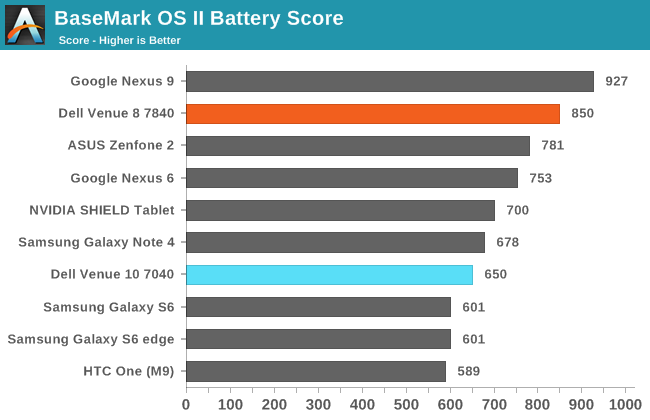

In BaseMark OS II we see that the Venue 10 has a fairly average result. The battery lifetime sits in the middle of the chart alongside the SHIELD Tablet and the Nexus 6. The battery score is lower than our other devices due to a high rate of battery drain. The Nexus 9 holds a clear advantage in both respects, and the Venue 8 also achieves both a higher score and a longer runtime as a result of its lower display power usage lowering the rate of battery depletion.
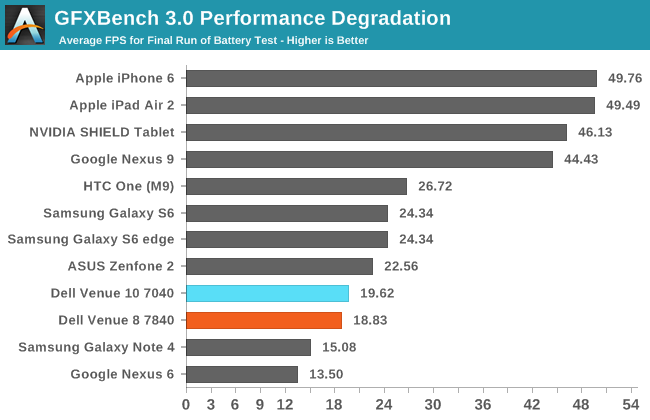
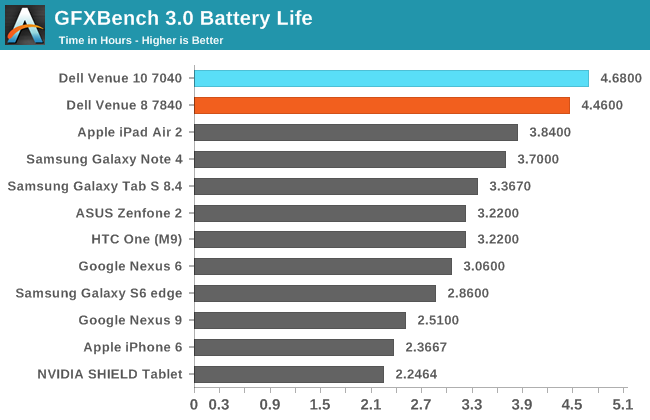
In GFXBench we see that the Venue 10 achieves almost the same results as the Venue 8. Battery life is at the very top of the chart, but this is partly due to the fact that there's not nearly as much GPU power as Apple, NVIDIA, and HTC are putting into in their tablets. The amount of performance the iPad Air 2 achieves with only a slightly shorter battery lifetime makes it a much better choice for gamers. However, something interesting to note is that the level of throttling is only on the scale of tenths of a frame per second. This means that in games where the Venue 10 does achieve a high frame rate users can expect it to stay there.
One thing I felt was important to note is that I had a lot of difficulty when running GFXBench's battery test. In two instances performance degraded to 3fps, and in another the tablet completely locked up. It was difficult to diagnose these issues, especially in the case of the freeze as the tablet had to be hard rebooted. In any case, it appears to be a software issue rather than a hardware one or a problem with heat, as the tablet felt no hotter during the run that maintained performance at ~19fps.
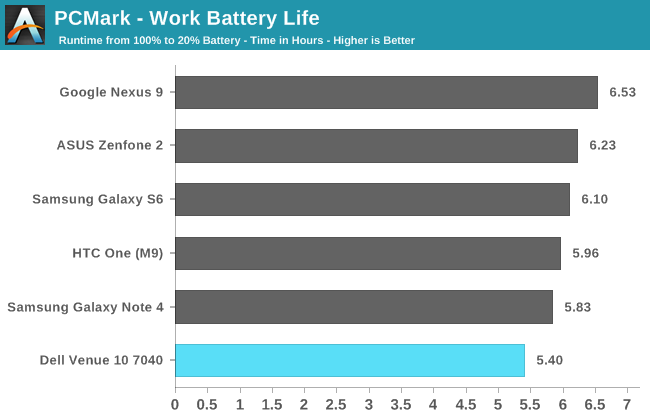
The last battery test is PCMark which runs the different tests from its performance benchmark. Like the benchmarks, the battery test is a good metric of how long a device will last during mixed use. We don't have many data points for this test yet, but as of right now the Venue 10 has the lowest result of all of our devices. If it was possible to test it at 215 nits there would definitely be improvement, but PCMark is not a heavily display-bound test and it would most likely still be behind the Nexus 9.
Charge Time
Charge time is the other half of the battery life story. An extremely long charge time can leave a device tethered to a wall for long periods even if it had great battery life while it was still charged. The Venue 10 comes with a 5V 2A charging block in the box, and it fortunately does not have any coil whine issues like I've experienced with other recent devices with high wattage chargers.
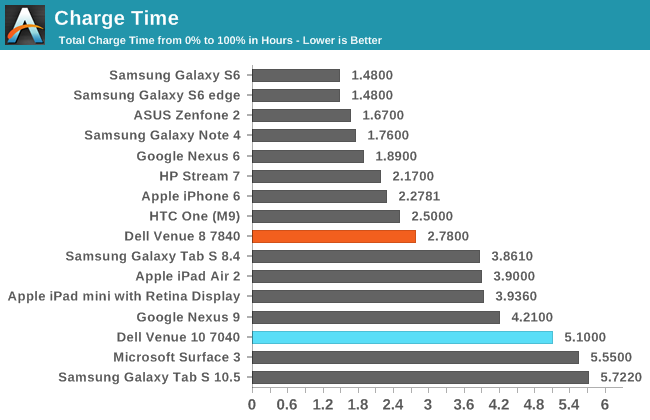
With the same charging block as the Venue 8 but a larger battery, it was inevitable that the Venue 10 would have a longer charging time. At 5.1 hours, the Venue 10's charge time is noticeably longer than the Nexus 9 or iPad Air 2. The bigger issue is that the battery depletes so quickly when web browsing, and so you spend a lot more time with the tablet charging than other devices. In this circumstance it actually took less time to drain the battery in the web browsing test than it took to charge it back to 100%. Including a 12W or 15W charger would have been a good decision on Dell's part.


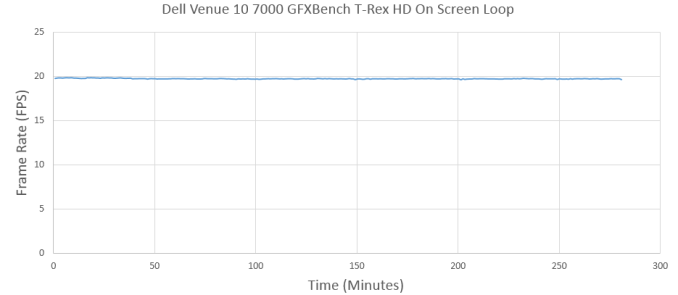








49 Comments
View All Comments
tsk2k - Tuesday, June 30, 2015 - link
When is the Carrizo review coming out?DigitalFreak - Tuesday, June 30, 2015 - link
I'll save you 8 pages of reading.It sucks.
Hulk - Wednesday, July 1, 2015 - link
Thanks you just saved me 15 minutes. And I'm being totally serious.kyuu - Thursday, July 2, 2015 - link
Can you and the other members of the AMD-hate circle jerk kindly stop infesting the comment section here? Anandtech is a site for people who want to read about tech, not indulge in mindless dickery. Thanks.maglito - Monday, July 6, 2015 - link
Probably when you can actually get a carrizo powered laptop / 2in1. Have you seen any for sale yet? I haven't, and I've been looking. I really want a laptop with 18Gbps HDMI (2.0) and hardware H.265 decode. They were supposed to be available by now....nightbringer57 - Tuesday, June 30, 2015 - link
About the 2 in 1 aspect...I feel the problem of this market niche is the harsh competition from windows 8.1 (soon to be 10) "Tabletbooks" (2 - 1 tablet + netbook devices like the asus T100). Those are really common and you can get very good models around 200-300€. You can really put the keyboard to full use with the (almost) full-fledged Windows compatibility. If you're gonna buy a not-so-good tablet just because it can make an awesome netbook when you need it, those models kick in and ass.
JeremyInNZ - Tuesday, June 30, 2015 - link
The Sony Z4 tablet is arguably the best 10" Android tablet on the market. It also comes with a keyboard doc, and does a much better job then the Dell with it. Just because Dell did a poor job of implementing the idea, does not make it a bad idea.zimanodenea - Tuesday, June 30, 2015 - link
Intel + PowerVR. I'd rather eat dog poop than buy into this combination again.lilmoe - Tuesday, June 30, 2015 - link
What were you expecting? We all know that last generation ATOM's iGPUs suck (and the current x7 sucks a little less). Wait for a $499 Core M tablet if you want something "interesting", and make sure it doesn't go above 1080p if you want 10+ hours of battery life...Samus - Wednesday, July 1, 2015 - link
The elephant in the room here is that this is a $500 Android tablet. $500. Starting price. If it were running Windows this would be a legitimate competitor to the Surface 3.The reality is you can buy two really decent Android tablets for the same price as this, specifically the Asus Transformer. This is basically a $200 Nextbook Ares (includes keyboard) for triple the price. I don't know what Dell is doing here. Covering something in Aluminum doesn't triple its value.